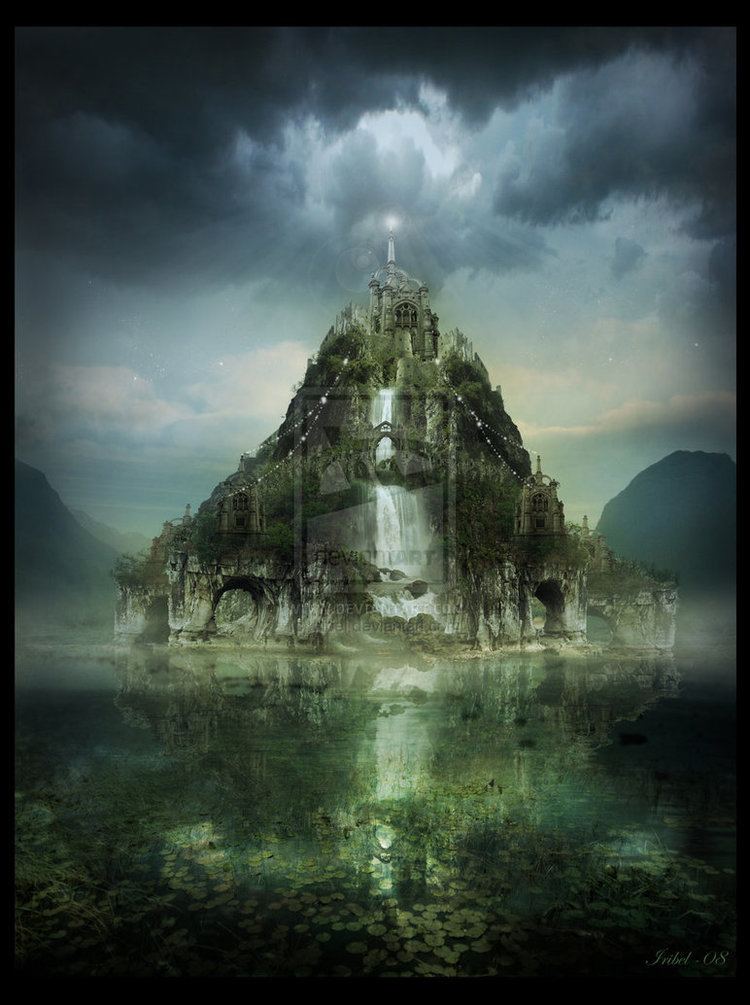Genre Arthurian legend | ||
 | ||
Type Legendary idyllic island Notable people King Arthur, Morgan le Fay | ||
Avalon live set at ozora festival 2015
Avalon (/ˈævəˌlɒn/; Latin: Insula Avallonis, Old French Avalon, Welsh: Ynys Afallon, Ynys Afallach; literally meaning "the isle of fruit [or apple] trees") is a legendary island featured in the Arthurian legend. It first appears in Geoffrey of Monmouth's 1136 pseudo-historical account Historia Regum Britanniae ("The History of the Kings of Britain") as the place where King Arthur's sword Excalibur was forged and later where Arthur was taken to recover from his wounds after the Battle of Camlann. Avalon was associated from an early date with mystical practices and people such as Morgan le Fay.
Contents
- Avalon live set at ozora festival 2015
- Avalon laughing buddha wake bake
- Etymology
- In Arthurian legend
- Connection to Glastonbury
- Other locations for Avalon
- References

Avalon laughing buddha wake bake
Etymology

Geoffrey of Monmouth referred to it in Latin as Insula Avallonis in the Historia. In the later Vita Merlini he called it Insula Pomorum the "isle of fruit trees" (from Latin pōmus "fruit tree"). The name is generally considered to be of Welsh origin (though an Old Cornish or Old Breton origin is also possible), derived from Old Welsh, Old Cornish, or Old Breton aball or avallen(n), "apple tree, fruit tree" (cf. afall in Modern Welsh, derived from Common Celtic *abalnā). It is also possible that the tradition of an "apple" island among the British was influenced by Irish legends concerning the otherworld island home of Manannán mac Lir and Lugh, Emain Ablach (also the Old Irish poetic name for the Isle of Man), where Ablach means "Having Apple Trees" – derived from Old Irish aball ("apple")—and is similar to the Middle Welsh name Afallach, which was used to replace the name Avalon in medieval Welsh translations of French and Latin Arthurian tales. All are etymologically related to the Gaulish root *aballo- (as found in the place name Aballo/Aballone, now Avallon in Burgundy or in the Italian surname Avallone) and are derived from a Common Celtic *abal- "apple", which is related at the Proto-Indo-European level to English apple, Russian яблоко (jabloko), Latvian ābele, et al.
In Arthurian legend

According to Geoffrey in the Historia and much subsequent literature which he inspired, Avalon is the place where King Arthur is taken after fighting Mordred at the Battle of Camlann to recover from his wounds. Welsh, Cornish and Breton tradition claimed that Arthur had never really died, but would inexorably return to lead his people against their enemies. The Historia also states that Avalon is where his sword Excalibur was forged. Geoffrey dealt with Avalon in more detail in Vita Merlini, in which he describes for the first time in Arthurian legend the enchantress Morgan le Fay as the chief of nine sisters (Moronoe, Mazoe, Gliten, Glitonea, Gliton, Tyronoe, Thiten and Thiton) who live on Avalon. Geoffrey's description of the island indicates a sea voyage was needed to get there. His description of Avalon here, which is heavily indebted to the early medieval Spanish scholar Isidore of Seville (being mostly derived from the section on famous islands in Isidore's famous work Etymologiae, XIV.6.8 "Fortunatae Insulae"), shows the magical nature of the island:

By comparison, Isidore's description of the Fortunate Isles reads:

In medieval geographies, Isidore's Fortunate Islands were identified with the Canaries.
Connection to Glastonbury
Around 1190, Avalon became associated with Glastonbury, when monks at Glastonbury Abbey claimed to have discovered the bones of Arthur and his queen. The works of Gerald of Wales make the first known connection:
What is now known as Glastonbury was, in ancient times, called the Isle of Avalon. It is virtually an island, for it is completely surrounded by marshlands. In Welsh it is called Ynys Afallach, which means the Island of Apples and this fruit once grew in great abundance. After the Battle of Camlann, a noblewoman called Morgan, later the ruler and patroness of these parts as well as being a close blood-relation of King Arthur, carried him off to the island, now known as Glastonbury, so that his wounds could be cared for. Years ago the district had also been called Ynys Gutrin in Welsh, that is the Island of Glass, and from these words the invading Saxons later coined the place-name 'Glastingebury'.Though no longer an island in the twelfth century, the high conical bulk of Glastonbury Tor had been surrounded by marsh before the surrounding fenland in the Somerset Levels was drained. In ancient times, Ponter's Ball Dyke would have guarded the only entrance to the island. The Romans eventually built another road to the island. Gerald wrote that Glastonbury's earliest name in Welsh was Ineswitrin (or Ynys Witrin), the Isle of glass, a name noted by earlier historians which suggests that the location was at one point seen as an island. The discovery of the burial is described by chroniclers, notably Gerald of Wales, as being just after King Henry II's reign when the new abbot of Glastonbury, Henry de Sully, commissioned a search of the abbey grounds. At a depth of 5 m (16 feet) the monks were said to have discovered a massive treetrunk coffin and a leaden cross bearing the inscription:
Accounts of the exact inscription vary, with five different versions existing. The earliest is by Gerald in "Liber de Principis instructione" c. 1193, who wrote that he viewed the cross in person and traced the lettering. His transcript reads: "Here lies buried the famous King Arthur ("Arthurus") with Guinevere ("Wenneveria") his second wife in the isle of Avalon". Inside the coffin were two bodies, who Giraldus refers to as Arthur and "his queen"; the bones of the male body were described as being gigantic. The account of the burial by the chronicle of Margam Abbey says three bodies were found, the other being of Mordred. In 1278, the remains were reburied with great ceremony, attended by King Edward I and his queen, before the High Altar at Glastonbury Abbey, where they were the focus of pilgrimages until the Reformation.
The story is today seen as an example of pseudoarchaeology. Historians today generally dismiss the authenticity of the find, attributing it to a publicity stunt performed to raise funds to repair the Abbey, which was mostly burned in 1184. Long before this William of Malmesbury, a historian interested in Arthur, said in his history of England "But Arthur’s grave is nowhere seen, whence antiquity of fables still claims that he will return." As William wrote a comprehensive history of Glastonbury De antiquitae Glatoniensis ecclesie around 1130 which discussed many pious legends connected to the Abbey, but made no mention of either Arthur's grave or a connection of Glastonbury to the name Avalon, stating firmly it was previously known as Ineswitrin, this raises further suspicions concerning the burial. It is known for certain the monks later added forged passages to William's history discussing Arthurian connections. The fact that the search for the body is connected to Henry II and Edward I, both kings who fought major Welsh wars, has had scholars suggest that propaganda may have played a part as well. Gerald, a constant supporter of royal authority, in his account of the discovery clearly aims to destroy the idea of the possibility of King's Arthur's messianic return: "Many tales are told and many legends have been invented about King Arthur and his mysterious ending. In their stupidity the British [i.e. Welsh, Cornish and Bretons] people maintain that he is still alive. Now that the truth is known, I have taken the trouble to add a few more details in this present chapter. The fairy-tales have been snuffed out, and the true and indubitable facts are made known, so that what really happened must be made crystal clear to all and separated from the myths which have accumulated on the subject."
The burial discovery ensured that in later romances, histories based on them and in the popular imagination Glastonbury became increasingly identified with Avalon, an identification that continues strongly today. The later development of the legends of the Holy Grail and Joseph of Arimathea by Robert de Boron interconnected these legends with Glastonbury and with Avalon, an identification which also seems to be made in Perlesvaus. The popularity of Arthurian Romance has meant this area of the Somerset Levels has today become popularly described as The Vale of Avalon. In more recent times writers such as Dion Fortune, John Michell, Nicholas Mann and Geoffrey Ashe have formed theories based on perceived connections between Glastonbury and Celtic legends of the otherworld and Annwn in attempts to link the location firmly with Avalon, drawing on the various legends based on Glastonbury Tor as well as drawing on ideas like Earth mysteries, Ley lines and even the myth of Atlantis. Arthurian literature also continues to use Glastonbury as an important location as in The Mists of Avalon, A Glastonbury Romance and The Bones of Avalon. Even the fact that Somerset has many apple orchards has been drawn in to support the connection. Glastonbury's connection to Avalon continues to make it a site of tourism and the area has great religious significance for Neopagans, Neo-druids and as a New Age community, as well as Christians. Hippy identification of Glastonbury with Avalon seen in the work of Michell and in Gandalf's Garden also helped inspire the Glastonbury Festival.
Other locations for Avalon
In medieval times suggestions for the location of Avalon ranged far beyond Glastonbury. They included on the other side of the Earth at the antipodes, Sicily, and other unnamed locations in the Mediterranean.
In more recent times, just like in the quest for Arthur's mythical capital Camelot, a large number of locations have been put forward as being the real "Avalon". Geoffrey Ashe suggests an association of Avalon with the town of Avallon in Burgundy, as part of a theory connecting King Arthur to the Romano-British leader Riothamus who campaigned in that area.
